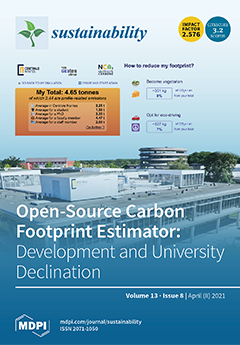Elevated tropospheric ozone (O
3) concentration may substantially influence the below-ground processes of terrestrial ecosystems. Nevertheless, a comprehensive and quantitative understanding of O
3 impacts on soil CO
2 emission remains elusive, making the future sources or sinks of soil C uncertain.
[...] Read more.
Elevated tropospheric ozone (O
3) concentration may substantially influence the below-ground processes of terrestrial ecosystems. Nevertheless, a comprehensive and quantitative understanding of O
3 impacts on soil CO
2 emission remains elusive, making the future sources or sinks of soil C uncertain. In this study, 77 pairs of observations (i.e., elevated O
3 concentration treatment versus control) extracted from 16 peer-reviewed studies were synthesized using meta-analysis. The results depicted that soil CO
2 efflux was significantly reduced under short-term O
3 exposure (≤1 year,
p < 0.05), while it was increased under extended duration (>1 year,
p < 0.05). Particularly, soil CO
2 emission was stimulated in nonagricultural ecosystems, in the free-air CO
2 enrichment (FACE) experiment, and in the soils of lower pH. The effect sizes of soil CO
2 efflux were significantly positively correlated with experimental duration and were significantly negatively correlated with soil pH, respectively. The ozone effect on soil CO
2 efflux would be enhanced at warm temperatures and high precipitation. The duration of O
3 exposure was the fundamental factor in analyzing O
3 impacts on soil CO
2 emission.
Full article





